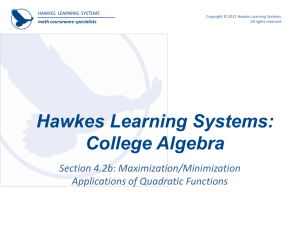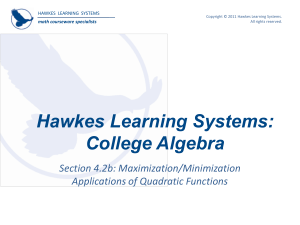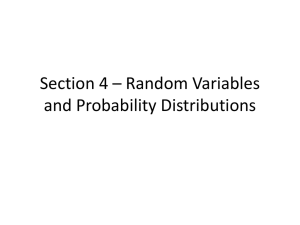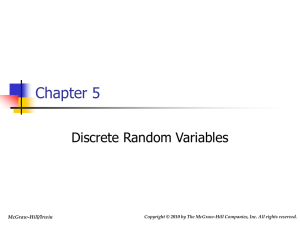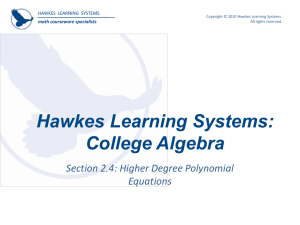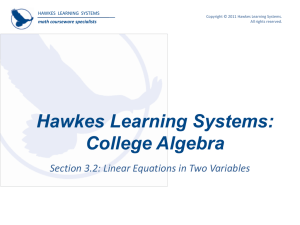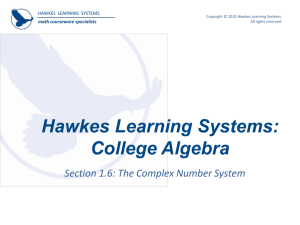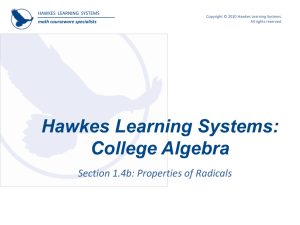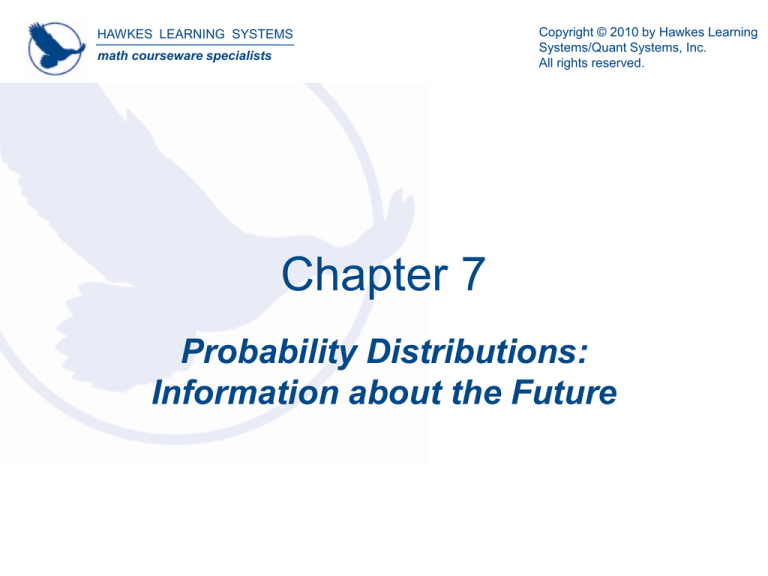
HAWKES LEARNING SYSTEMS
math courseware specialists
Copyright © 2010 by Hawkes Learning
Systems/Quant Systems, Inc.
All rights reserved.
Chapter 7
Probability Distributions:
Information about the Future
HAWKES LEARNING SYSTEMS
Probability Distributions: Information about the Future
math courseware specialists
Section 7.1 Types of Random Variables
Objectives:
• To define discrete random variables.
• To define continuous random variables.
• To describe probability notation.
HAWKES LEARNING SYSTEMS
Probability Distributions: Information about the Future
math courseware specialists
Section 7.1 Types of Random Variables
Definitions:
•
Random variable – a numerical outcome of a random
process.
•
Probability distribution – a model which describes a specific
kind of random process.
•
Discrete random variable – a random variable which has a
countable number of possible outcomes.
•
Continuous random variable – a random variable that can
assume any value on a continuous segment(s) of the real
number line.
HAWKES LEARNING SYSTEMS
Probability Distributions: Information about the Future
math courseware specialists
Section 7.1 Types of Random Variables
Notation for Random Variables:
• Capital letters, such as X, will be used to refer to the random
variable, while small letters, such as x, will refer to specific values
of the random variable. Often the specific values will be
subscripted,
x1, x2, ... , xn .
Discrete Random Variables:
• To describe a discrete random variable:
• State the variable.
• List all the possible values of the variable.
• Determine the probabilities of these values.
HAWKES LEARNING SYSTEMS
Probability Distributions: Information about the Future
math courseware specialists
Section 7.1 Types of Random Variables
Example:
Toss a die and observe the outcome of the toss.
Value of X
First list the three steps:
1
• State the variable:
X = the outcome of the toss of the die.
2
3
4
• List the possible values:
1, 2, 3, 4, 5, 6. In this case
5
x1 1, x2 2, x3 3, x4 4, x5 5, and x6 6.
6
• Determine the probability of each value.
Probability
1
6
1
6
1
6
1
6
1
6
1
6
HAWKES LEARNING SYSTEMS
Probability Distributions: Information about the Future
math courseware specialists
Section 7.1 Types of Random Variables
Describing a Continuous Random Variable:
•Time between failure. Calculate the time between installing a
brake light in your car and the time the light ceases to work.
• Defining a continuous random variable is very similar to defining
a discrete random variable.
• Indentify the random variable:
X = Time between installation and failure.
• Indentify the range of values:
Between zero and infinity, note X is measured on a
continuous scale.
• Define the probability density:
Unknown, but probably would be modeled on historical
data and is most likely exponentially distributed.
• Note: for continuous random variables, we specify probabilities
with probability density functions.
HAWKES LEARNING SYSTEMS
ProbabilityChapter
Distributions:
NameInformation about the Future
math courseware specialists
Section 7.2
Section
Discrete
## Section
Probability
Name
Distributions
Objectives:
• To describe the characteristics of a discrete random variable.
HAWKES LEARNING SYSTEMS
Probability Distributions: Information about the Future
math courseware specialists
Section 7.2 Discrete Probability Distributions
Definition:
•
Discrete Probability Distribution – all possible values of a
random variable with their associated probabilities.
Characteristics of Discrete Probability Distributions:
• The sum of all probabilities must equal 1.
• The probability of any value must be between 0 and 1,
inclusively.
HAWKES LEARNING SYSTEMS
Probability Distributions: Information about the Future
math courseware specialists
Section 7.2 Discrete Probability Distributions
Example:
Create a probability distribution for X, the number of heads in four
tosses of a coin.
Solution:
• To begin, list all possible values of X.
• Then, to find the probability distribution, we need to calculate the
probability of each outcome.
Tossing a Coin
x
0
1
2
3
4
P(X=x)
1
16
4
16
6
16
4
16
1
16
P x 1.0
Simple Events
TTTT
HTTT
THTT
TTHT
TTTH
HHTT
HTTH
TTHH
THHT
HHHT
HHTH
HTHH
THHH
HHHH
THTH
HTHT
HAWKES LEARNING SYSTEMS
Probability Distributions: Information about the Future
math courseware specialists
Section 7.2 Discrete Probability Distributions
Example:
The probability distribution for the price of a stock thirty days
from now is given below. Find the probability the price of the
stock with be greater than $56.
Solution:
Stock Prices
x
P(X=x)
54.5
.05
55.0
.10
55.5
.25
56.0
.30
56.5
.20
57.0
.10
P x 1.0
Based on the probability distribution, the
probability that the stock price will be more than
$56 in thirty days is calculated as follows:
P X 56 P X 56.5 P X 57.0
.20 .10
.30
HAWKES LEARNING SYSTEMS
Probability Distributions: Information about the Future
math courseware specialists
Section 7.3 Expected Value
Objectives:
• To define and describe the expected value of a discrete
random variable.
HAWKES LEARNING SYSTEMS
Probability Distributions: Information about the Future
math courseware specialists
Section 7.3 Expected Value
Expected Value:
•
The expected value of the random variable X is the
mean of the random variable X. It is denoted by E(X).
E X x p x , where p x P X x .
HAWKES LEARNING SYSTEMS
Probability Distributions: Information about the Future
math courseware specialists
Section 7.3 Expected Value
Example:
John sells cars. Calculate the expected value of the number of cars
John sells per day.
Solution:
Car Sales
x
P(X=x)
0
1
2
3
.15
.30
.35
.15
.05
4
x P X x
0
0.30
0.70
0.45
0.20
E X 1.65
E X x P X x
0 .15 1.30
2 .35 3 .15
4 .05
0 0.30 0.70 0.45
0.20
1.65
HAWKES LEARNING SYSTEMS
Probability Distributions: Information about the Future
math courseware specialists
Section 7.3 Expected Value
Example:
You are trying to decide between two different investment
options. The two plans are summarized in the table below. The
left-hand column for each plan gives the potential profits, and
the right-hand columns give their respective probabilities.
Which plan should you choose?
Expected Value
Investment A
Investment B
Profit
Probability
Profit
Probability
$1200
.1
$1500
.3
$950
.2
$800
.1
$130
.4
–$100
.2
–$575
.1
–$250
.2
–$1400
.2
–$690
.2
HAWKES LEARNING SYSTEMS
Probability Distributions: Information about the Future
math courseware specialists
Section 7.3 Expected Value
Solution:
• It is difficult to determine which plan is better by simply looking at
the table.
• Let’s use the expected value to compare the plans.
For Investment A:
E(X) = (1200)(.1) + (950)(.2) + (130)(.4) + (–575)(.1) + (–1400)(.2)
= 120 + 190 + 52 – 57.50 – 280
= $24.50
For Investment B:
E(X) = (1500)(.3) + (800)(.1) + (–100)(.2) + (–250)(.2) + (–690)(.2)
= 450 + 80 – 20 – 50 – 138
= $322.00
Best option
HAWKES LEARNING SYSTEMS
Probability Distributions: Information about the Future
math courseware specialists
Section 7.4 Variance of a Discrete Random Variable
Objectives:
• To define and describe the variance of a discrete random
variable.
HAWKES LEARNING SYSTEMS
Probability Distributions: Information about the Future
math courseware specialists
Section 7.4 Variance of a Discrete Random Variable
Variance of a Discrete Random Variable:
V X = x - p x
2
• The standard deviation is computed by taking the square root
of the variance:
Standard Deviation= V X
• Variance in investments reflects greater risks.
HAWKES LEARNING SYSTEMS
Probability Distributions: Information about the Future
math courseware specialists
Section 7.4 Variance of a Discrete Random Variable
Determine the Risk:
To determine the risk, we need to calculate the variance of
each investment.
Variance of a Random Variable
Investment A
Investment B
Profit
Probability
Profit
Probability
$1200
.1
$1500
.3
$950
.2
$800
.1
$130
.4
–$100
.2
–$575
.1
–$250
.2
–$1400
.2
–$690
.2
HAWKES LEARNING SYSTEMS
Probability Distributions: Information about the Future
math courseware specialists
Section 7.4 Variance of a Discrete Random Variable
Solution:
For Investment A:
E X A A 24.50
Variance of a Random Variable
Investment A
Profit
Probability
x -
2
px
1200 24.50 0.1 138,180.03
2
$950
.2
950 24.50 0.2 171,310.05
2
$130
.4
130
24.50
0.4 4452.10
2
–$575
.1
575 24.50 0.1 35,940.03
2
–$1400
.2
1400 24.50 0.2 405,840.05
V X $755,722.26
Standard Deviation V X 755,722.24 $869.32
$1200
.1
2
HAWKES LEARNING SYSTEMS
Probability Distributions: Information about the Future
math courseware specialists
Section 7.4 Variance of a Discrete Random Variable
Solution:
For Investment B:
E X B B 322
Variance of a Random Variable
Investment B
Profit
Probability
$1500
.3
$800
.1
–$100
.2
–$250
.2
–$690
.2
Standard Deviation
x -
2
px
1500 322 0.3 416,305.20
2
800 322 0.1 22,848.40
2
100
322
0.2 35,616.80
2
250 322 0.2 65,436.80
2
690 322 0.2 204,828.80
V X $745,036.00
V X 745,036.00 $863.15
2
HAWKES LEARNING SYSTEMS
Probability Distributions: Information about the Future
math courseware specialists
Section 7.4 Variance of a Discrete Random Variable
Solution:
Since V X A 755,722.26 745,036.00 V X B , in terms of
risk Investment B is considered the better option because it
carries slightly less risk.
HAWKES LEARNING SYSTEMS
Probability Distributions: Information about the Future
math courseware specialists
Section 7.7 The Binomial Distribution
Objectives:
• To define a Binomial random variable.
• To calculate probabilities using the Binomial distribution.
• To calculate the expected value of a Binomial random variable.
• To calculate the variance of a Binomial random variable.
HAWKES LEARNING SYSTEMS
Probability Distributions: Information about the Future
math courseware specialists
Section 7.7 The Binomial Distribution
Definition:
•
Binomial experiment – a random experiment which satisfies
all of the following conditions.
i) There are only two outcomes on each trial of the experiment.
(One of the outcomes is usually referred to as a success, and
the other as a failure.)
ii) The experiment consists of n identical trials as described in
Condition 1.
iii) The probability of success on any one trial is denoted by p and
does not change from trial to trial. (Note that the probability of
a failure is 1−p and also does not change from trial to trial.)
iv) The trials are independent.
v) The binomial random variable X is the count of the number of
successes in n trials.
HAWKES LEARNING SYSTEMS
Probability Distributions: Information about the Future
math courseware specialists
Section 7.7 The Binomial Distribution
Example:
Toss a coin 5 times and observe the number of heads. Define the
experiment in terms of our definition of a binomial experiment.
Solution:
i.
ii.
There are only two outcomes, heads or tails.
The experiment will consist of five tosses of a coin.
(Hence: n = 5.)
iii. The probability of getting a head (success) is 1 and does not
1
change from trial to trial. (Hence: p = .)
2
2
iv. The outcome of one toss will not affect other tosses.
v. The variable of interest is the count of the number of heads in
5 tosses.
HAWKES LEARNING SYSTEMS
Probability Distributions: Information about the Future
math courseware specialists
Section 7.7 The Binomial Distribution
Example:
Toss a coin 4 times and observe the number of heads. Create the
probability distribution for the number of heads.
Solution:
Tossing a Coin
Events
Number
of Heads
TTTT
0
HTTT, THTT, TTHT, TTTH
1
HHTT, HTHT, HTTH, THHT, THTH, TTHH
2
THHH, HTHH, HHTH, HHHT
3
HHHH
4
Probability
1
16
4
16
6
16
4
16
1
16
HAWKES LEARNING SYSTEMS
Probability Distributions: Information about the Future
math courseware specialists
Section 7.7 The Binomial Distribution
Binomial Probability Distribution Function:
We will define the binomial probability distribution function as
follows:
nx
P X x C p 1 p
n
x
x
Cxn represents the number of combinations of n objects taken x at a
time (without replacement) and is given by
Cxn
n!
, where n ! n n 1 n 2 ...1 and 0!=1.
x ! n x !
where n the number of trials,
x the number of successes, and
p the probability of success.
HAWKES LEARNING SYSTEMS
Probability Distributions: Information about the Future
math courseware specialists
Section 7.7 The Binomial Distribution
Example:
What is the probability of getting exactly 7 tails in 18 coin
tosses?
Solution:
n = 18, p = .5, x = 7
P X x Cxn p x 1 p
7
nx
18 7
1 1
P X 7 C718 1
2 2
7
11
18! 1 1
11!7! 2 2
HAWKES LEARNING SYSTEMS
Probability Distributions: Information about the Future
math courseware specialists
Section 7.7 The Binomial Distribution
Example:
A quality control expert at a large factory estimates that 10% of
all batteries produced are defective. If a sample of 20 batteries
are taken, what is the probability that no more than 3 are
defective?
Solution:
n = 20, p = .1, x = 3, but this time we need to look at the
probability that no more than three are defective, which is
P(X ≤ 3).
P X 3 P X 0 P X 1 P X 2 P X 3
C020 0.1 0.9 C120 0.1 0.9
0
20
2
C
20
0.1 0.9
0.867
2
18
1
C
20
3
19
0.1 0.9
3
17
HAWKES LEARNING SYSTEMS
Probability Distributions: Information about the Future
math courseware specialists
Section 7.7 The Binomial Distribution
Formulas:
Binomial expected value and variance can be defined with the
following formulas.
E X np
V X np 1 p
Example:
A quality control expert at a large factory estimates that 10% of
all batteries produced are defective. If a sample of 20 batteries
is taken, what is the expected value, variance, and standard
deviation of the number of defective batteries?
Solution:
n 20, p .1
E X 20 0.1 2
V X 20 0.11 0.1 1.8
Standard Deviation= V X 1.8 1.34
HAWKES LEARNING SYSTEMS
Probability Distributions: Information about the Future
math courseware specialists
Section 7.8 The Poisson Distribution
Objectives:
• To define a Poisson random variable.
• To calculate probabilities using the Poisson distribution.
HAWKES LEARNING SYSTEMS
Probability Distributions: Information about the Future
math courseware specialists
Section 7.8 The Poisson Distribution
Definitions:
• Poisson distribution – a discrete probability
distribution that uses a fixed interval of time or
space in which the number of successes are
recorded.
e x
P X x
, for x 0,1,2,...
x!
where
e 2.71828..., and
average number of "successes".
• In the Poisson distribution E X V X .
HAWKES LEARNING SYSTEMS
Probability Distributions: Information about the Future
math courseware specialists
Section 7.8 The Poisson Distribution
Poisson Distribution Guidelines:
1.
2.
The successes must occur one at a time.
Each success must be independent of any other successes.
When calculating the Poisson distribution, round your answers to four
decimal places.
HAWKES LEARNING SYSTEMS
Probability Distributions: Information about the Future
math courseware specialists
Section 7.8 The Poisson Distribution
Example:
Suppose that the dial-up Internet connection at your home goes
out an average of 0.75 times every hour. If you plan to be
connected to the internet for 3 hours one afternoon, what is the
probability that you will stay connected the entire time?
Assume that the dial-up disconnections follow a Poisson
distribution.
Solution:
x = 0, (0.75)(3) = 2.25
0.1054
HAWKES LEARNING SYSTEMS
Probability Distributions: Information about the Future
math courseware specialists
Section 7.8 The Poisson Distribution
Example:
A typist averages 1 typographical error per paragraph. If the
document has 4 paragraphs, what is the probability that there
will be less than 5 mistakes?
Solution:
x < 5, = (4)(1) = 4
This time we need to look at the probability that less than five
mistakes will occur, which is P(X < 5).
P(X < 5) = P(X ≤ 4)
0.6288
HAWKES LEARNING SYSTEMS
Probability Distributions: Information about the Future
math courseware specialists
Section 7.8 The Poisson Distribution
Example:
A fast food restaurant averages 2 incorrect orders every 4 hours.
What is the probability that they will get at least 3 orders wrong in
any given day between 11 AM and 11PM? Assume that fast food
errors follow a Poisson distribution.
Solution:
x ≥ 3, = (3)(2) = 6
This time we need to look at the probability that at least three
wrong orders will occur, which is P(X ≥ 3).
P(X ≥ 3) = 1 – P(X < 3)
= 1 – P(X ≤ 2)
e 6 6 0 e 6 6 1 e 6 6 2
1
0!
1!
2!
0.9380
HAWKES LEARNING SYSTEMS
Probability Distributions: Information about the Future
math courseware specialists
Section 7.9 The Hypergeometric Distribution
Objectives:
• To define a Hypergeometric random variable.
• To calculate probabilities using the Hypergeometric distribution.
• To calculate the expected value of a Hypergeometric random
variable.
• To calculate the variance of a Hypergeometric random variable.
HAWKES LEARNING SYSTEMS
Probability Distributions: Information about the Future
math courseware specialists
Section 7.9 The Hypergeometric Distribution
Definitions:
•
Hypergeometric distribution – a special discrete probability
function for problems with a fixed number of dependent trials
and a specified number of countable successes.
CxACnNxA
P X x
, where 0 x min A, n
N
Cn
A the total number of successes possible
N the size of the population, and
n the size of the sample drawn.
•
When calculating the hypergeometric distribution, round your
answers to four decimal places.
HAWKES LEARNING SYSTEMS
Probability Distributions: Information about the Future
math courseware specialists
Section 7.9 The Hypergeometric Distribution
Hypergeometric Distribution Guidelines:
1.
2.
3.
4.
Each trial consists of selecting one of the N items in the
population and results in either a success or a failure.
The experiment consists of n trials.
The total number of possible successes in the entire
population is A.
The trials are dependent. (i.e., selections are made without
replacement.)
HAWKES LEARNING SYSTEMS
Probability Distributions: Information about the Future
math courseware specialists
Section 7.9 The Hypergeometric Distribution
Example:
At the local grocery store there are 50 boxes of cereal on the
shelf, half of which contain a prize. Suppose you buy 4 boxes
of cereal. What is the probability that 3 boxes contain a prize?
Solution:
A = 25, x = 3, N = 50, n = 4
C325C450325
P X 3
C450
C325C125
C450
2300 25
0.2497
230300
HAWKES LEARNING SYSTEMS
Probability Distributions: Information about the Future
math courseware specialists
Section 7.9 The Hypergeometric Distribution
Example:
A produce distributor is carrying 10 boxes of Granny Smith apples
and 8 boxes of Golden Delicious apples. If 6 boxes are randomly
delivered to one local market, what is the probability that at least
4 of the boxes delivered contain Golden Delicious apples?
Solution:
A = 8, x ≥ 4, N = 18, n = 6
P X 4 P X 4 P X 5 P X 6
C48C61848 C58C61858 C68C61868
18
18
C6
C6
C618
70 45 56 10 28 1
18564 18564 18564
0.2014
HAWKES LEARNING SYSTEMS
Probability Distributions: Information about the Future
math courseware specialists
Section 7.9 The Hypergeometric Distribution
Formulas:
Hypergeometric expected value and variance can be defined
with the following formulas.
EX n
A
N
A
A N n
V X n 1
N
N
N
1
HAWKES LEARNING SYSTEMS
Probability Distributions: Information about the Future
math courseware specialists
Section 7.9 The Hypergeometric Distribution
Example:
A produce distributor is carrying 10 boxes of Granny Smith apples
and 8 boxes of Golden Delicious apples. If 6 boxes are randomly
delivered to one local market, what is the expected value and
variance of the distribution?
Solution:
A = 8, N = 18, n = 6
8 8
E X 6
18 3
8
8 18 6 160
V X 6 1
18
18
18
1
153



